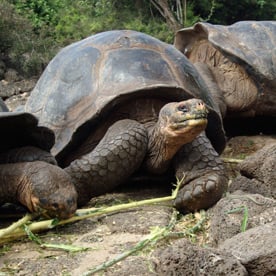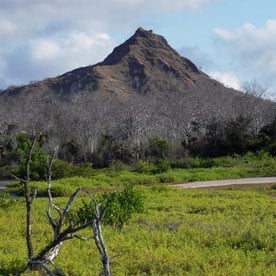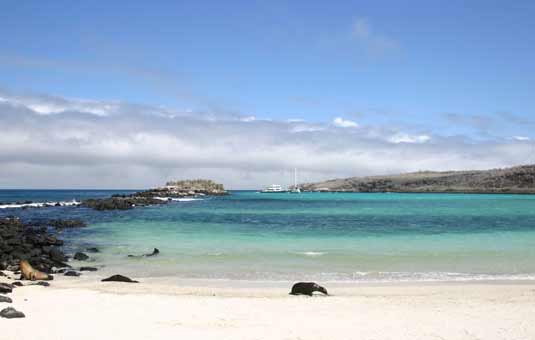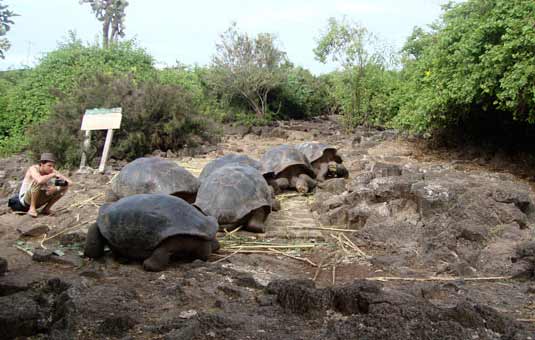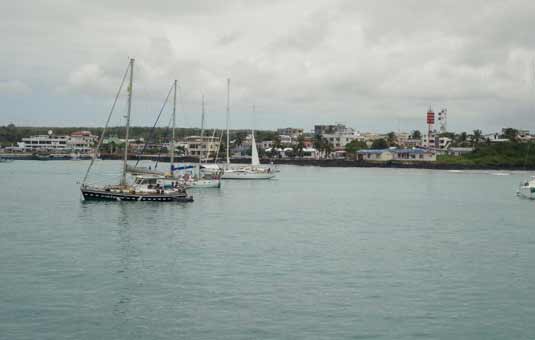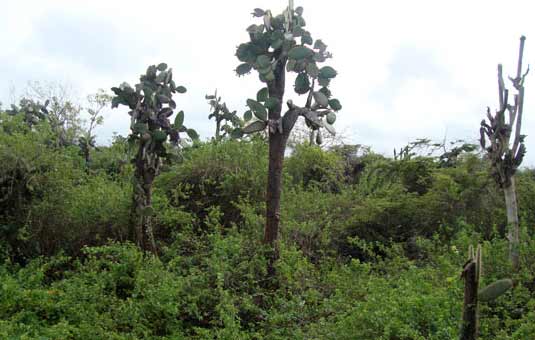Santa Cruz Island, Galapagos
Home to the largest town in the Galapagos, Puerto Ayora, the Island has a large variety of vegetation. Pit craters, Scalesia Forest, cacti and ferns are found in its vegetation zones. The island is comprised of a younger part formed by volcanic cones and lava and an older narrow strip of land formed by uplifted lava flows and tuffs.
Santa Cruz Fast Facts
- Santa Cruz is the only island with six different vegetation zones.
- Animals: Giant tortoises, land and marine iguanas, variety of birds
- Area: 380 sq. mi
- Highest Point: 2,834 ft
» Santa Cruz Hotels
Santa Cruz Visitor sites:
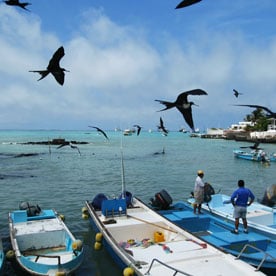
Puerto Ayora
Puerto Ayora is the economic centre of Galapagos with many restaurants, souvenir shops, discotheques, bars, internet coffee shops and other stores. The bay is a good location to spot brown pelicans, golden rays, marine iguanas, herons, lava gulls, frigate birds, Galapagos sea lions, and large numbers of blue-footed boobies.
- Highlights: Hammerhead shark babies, rays, sea turtles, sea birds
- Possible Activities: Dinghy ride
- Type of Landing: No Landing
- Difficulty: Easy
*Activities will be operated according to each boat itinerary.

Carrion Point
Carrion Point creates a sheltered lagoon with beautiful, turquoise water. During this visit you can snorkel and see a variety of fish, rays and perhaps the harmless white-tip reef sharks. The point is on the north coast of Santa Cruz Island at the entrance of Channel of Itabaca.
- Highlights: Fish, rays, white-tip reef sharks
- Possible Activities: Panga ride
- Type of Landing: No Landing
- Difficulty: Easy
*Activities will be operated according to each boat itinerary.
Charles Darwin Station / Fausto Llerena Breeding Center
The Charles Darwin Research Station is home to turtles ranging from 3-inches (new hatchlings) to 4-feet long. Subspecies of turtles interact with one another and many of the older turtles are accustomed to humans stretching out their heads for a photo opportunity. The babies are kept until they are about four years old and strong enough to survive on their own. More about the Charles Darwin Research Station
- Highlights: Giant tortoises in captivity
- Possible Activities: Walking
- Type of Landing: Dry landing
- Difficulty: Easy
*Activities will be operated according to each boat itinerary.
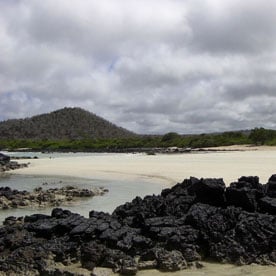
Garrapatero Beach
Situated on the northern side of Santa Cruz, El Garrapatero is a gorgeous sandy beach surrounded by mangroves. A fresh water lake behind the beach is home to flamingos, herons, stilts and other shore birds. The beautiful turquoise waters provide a good opportunity for swimming and snorkeling.
- Highlights: Gorgeous white sand beach, flamingos, herons, grebes, stilts
- Possible Activities: Swimming, snorkeling, kayaking
- Type of Landing: Dry landing
- Difficulty: Easy
*Activities will be operated according to each boat itinerary.
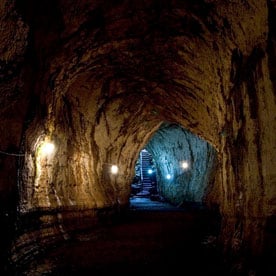
Lava Tunnels
The lava tunnels on Santa Cruz were formed as the outer skin of molten lava solidified but the liquid magma inside continued flowing, leaving behind a series of empty tubes. Visitors can walk through these underground channels, often more than a kilometer in length, and may have the opportunity to glimpse barn owls here.
- Highlights: Barn owls, finches
- Possible Activities: Walking
- Type of Landing: Dry landing
- Difficulty: Easy
*Activities will be operated according to each boat itinerary.

Tortuga Bay
The white-sand beach of Tortuga Bay gets its name from the black sea turtles that lay their eggs here. Other species to be seen include white-tip sharks and marine iguanas and the salt lagoon behind the mangroves is often frequented by flamingos. The site is excellent for bird watching and for enjoying a relaxing swim.
- Highlights: Beautiful white sandy beach, Galapagos green turtles, white-tip sharks, pelicans, ground finch
- Possible Activities: Swimming, snorkeling, surfing, bird watching
- Type of Landing: Dry landing
- Difficulty: Moderate (long)
*Activities will be operated according to each boat itinerary.
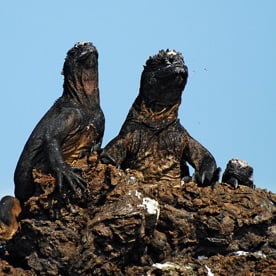
Whale Bay
Whale Bay is the site of one of the oldest whaling camps on Santa Cruz Island. It was to here and the other similar camps that the giant tortoises were brought before being loaded onboard the whalers and pirate ships. The semicircle beach is green in color, due to a high volume of olivine crystals. The curious Galapagos hawk can also found here.
- Highlights: Green beach
- Possible Activities: Galápagos hawks, Galápagos sea lions, marine iguanas, Darwin's finches, yellow warblers, frigate birds, blue-footed boobies
- Type of Landing: Wet landing
- Difficulty: Difficult walking
*Activities will be operated according to each boat itinerary.
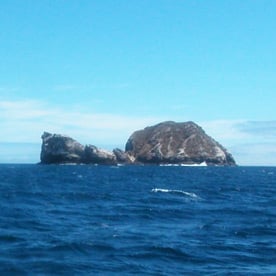
Gordon's Rock 
Located within a volcanic crater, this dive site is definitely not for beginners. With several pinnacles of rock, and often super strong currents blowing between these, the various currents can make this dive a tricky one. Famous for its hammerhead sightings, other amazing life is found here, like sting rays, manta rays, turtles and moray eels.
This partially submerged volcanic tuff cone has been referred to as "The Washing Machine" because of its strong currents. Oftentimes divers must grab hold of the rocky bottom or slope, and hold on, or crawl "front crawl style" in the direction of the dive plan.
- Highlights: Schools of hammerhead sharks
- Experience: Minimum advanced open water and 30 dives recommended. Experience in currents and surges.
- Depth: 7 m to 40 m (23 ft-131 ft). Average: 15 m to 30 m (49 -98 ft)
- Currents: Strong
- Average Water Temp: 17C-23C / 63F-73F
- Thermoclines: Moderate possibility
- Difficulty: Advanced
- Visibility: 7-20 meter average
*Activities will be operated according to each boat itinerary.

Bachas Beach
Located on the north shore of Santa Cruz, Las Bachas is a swimming beach. One of the few remnants of the U.S. World War II presence in the Galapagos, a floating pier, can be seen here. You may see flamingos, Sally Lightfoot crabs, hermit crabs, black necked stilts, and whimbrels. Sea turtles also nest off the beach.
- Highlights: World War II remnants
- Possible Activities: Walking, swimming
- Type of Landing: Wet Landing
- Difficulty: Easy
*Activities will be operated according to each boat itinerary.

Black Turtle Cove
Black Turtle Cove is situated in the northern part of Santa Cruz. This inlet is surrounded by mangroves and is only accessible by dinghy. The shallow cove is a safe haven for young marine life. Black-tip and white-tip reef sharks, sea turtles, and a variety of rays are often spotted here.
- Highlights: Hammerhead shark babies, rays, sea turtles, sea birds
- Possible Activities: Dinghy ride
- Type of Landing: No Landing
- Difficulty: Easy
*Activities will be operated according to each boat itinerary.
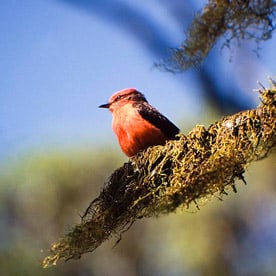
Cerro Mesa
At 490m above sea level, Cerro Mesa provides an impressive view of the archipelago. It is an excellent location to observe numerous endemic plants as well as up to 7 species of finch and the vermillion flycatcher. The area is characterized by a persistent drizzle ('la garúa') that falls horizontally throughout 8 months of the year. The west side features the largest crater on Santa Cruz.
- Highlights: Spectacular views, finches, vermillion flycatcher, crater
- Possible Activities: Walking, bird watching
- Type of Landing: Dry landing
- Difficulty: Easy
*Activities will be operated according to each boat itinerary.
Dragon Hill
Situated on Santa Cruz Island, Dragon Hill is one of the newest visitor sites accessible to tourists in the Galapagos Islands. One of the lengthier Galapagos walking trails will lead visitors along a beach and up a trail to the lagoon lookout where bright flamingos, pintail ducks, and land iguanas can be spotted. More about Dragon Hill
- Highlights: Land iguana nesting spot, Galapagos flamingos, common stilts, palo santo trees and cacti forest
- Possible Activities: Walking and hiking
- Type of Landing: Dry landing
- Difficulty: Easy to moderate: the trail may get muddy at times, and there is uneven rocky terrain.
*Activities will be operated according to each boat itinerary.
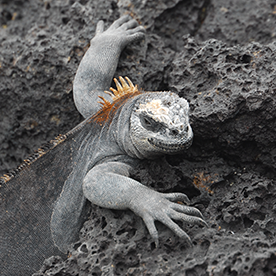
Eden Islet
Off the western coast of Santa Cruz Island, Eden Islet offers visitors a great chance to see a variety of Galapagos wildlife from the dinghy ride both on shore and under the water.
- Highlights: Endemic salemas , reef sharks, Nazca and blue footed boobies
- Possible Activities: Dinghy ride and snorkeling
- Type of Landing: No landing
- Difficulty: Easy
*Activities will be operated according to each boat itinerary.
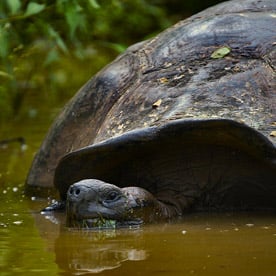
Highlands
Reached by bus from Puerto Ayora, the highlands of Santa Cruz are a deep green contrasting beautifully with much of the dry, lower islands. The dominant vegetation in the highlands is the forest of Scalesia trees creating the lush green color. The lava tubes, over half a mile long, are underground and walking through them is a unique, surreal experience.
- Highlights: Lava tunnels, wild turtles, tortoises breeding center.
- Possible Activities: Hike (1.5 miles/ 2 ½ km)
- Type of Landing: Dry landing
- Difficulty: Moderate (long)
*Activities will be operated according to each boat itinerary.
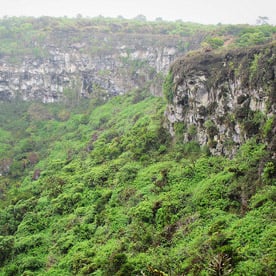
Twin Craters
Los Gemelos, or the Twin Craters, are located opposite each other on both sides of the road leading from Puerto Ayora to Baltra. The name is only figurative; not real craters, these formations were created by the collapse of surface material in underground fissures and chambers. The view is breathtaking.
- Highlights: Pit craters, Scalesia forest
- Possible Activities: Short hiking
- Type of Landing: Dry landing
- Difficulty: Moderate
*Activities will be operated according to each boat itinerary.

